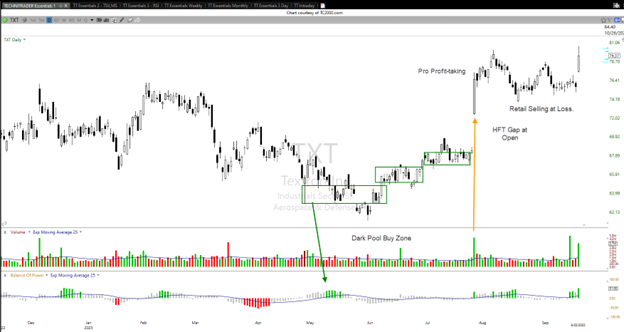–News Direct–
In any given market condition, there is a profit zone where most of the highly lucrative trades occur.
It is that sweet spot where a stock price is poised to move but has not moved yet. Most retail traders miss the profit zone and instead chase momentum runs that are already underway and often end up buying just as professional traders and HFTs are selling. The end result is a loss for the retail trader.
The sweet spot is the final price point at which the Dark Pool Buy-Side Giants cease their hidden accumulation, which Professional Traders identify and start their pre-run setups to trigger High Frequency Trading Firms, aka HFTs.
All of this activity goes on within a narrow sideways price range.
Heres how this works:
The Buy-Side Institutions, referred to as the Dark Pools here, buy stocks at bargain prices or when the company behind the stock is in a growth mode that is not yet part of the public news. Buy-Side Institutions visit companies regularly since they are the largest investors for these firms. The CEO and CFO provide plenty of information upon request. These visits occur before the end of a quarter and well ahead of the earnings report release date.
From this information, the Dark Pools either start accumulating more shares based on projected growth or start rotation to lower inventories of that stock to invest in a company poised for better earnings over time.
Their buying is always based on Quantitative Analysis of the fundamental data. Then, their Time-Weighted Average Price (TWAP) orders trigger automatically within a very narrow price range over an extended period of time, usually a few months. This makes their activity invisible to those who use Level 2 screens and retail traders looking for huge Volume-Weighted Average Price ranges or whale orders. It is a means by which the Dark Pools can acquire millions of shares of stock without disturbing a stocks volume or price trend, without creating momentum runs, and without front-running from the HFTs.
This controlled accumulation on Dark Pool venues creates a huge liquidity draw over time with tight price controls. Once the Dark Pools have acquired all the stock they want at that time, the Pro Traders see the shift via special indicators called Large-Lot versus Small-Lot indicators that are part of the new Hybrid Leading Indicators developed for the current market structure.
Professional Traders are Floor Traders, Independent Traders and Companies that provide professional trading for financial services companies. Pros want to nudge the HFTs into running or gapping the stock. When the Pro Traders set up deliberately to trigger the programs of the HFTs, they do not disturb price much either. Their goal is a penny spread and a tight low-risk entry. If the professionals are swinging a large lot of 1 to 5 million, they will divide it into lots that are not going to create a huge spike in volume on a single day.
HFTs have 4 primary strategies they use for their automated triggering system. One of those is technical analysis. HFT technical programs generally are searching for high volume with minimal price movement. The algorithms are based on the belief that huge orders can be found where there are huge volume surges.
The HFTs identify the pro trader setups and then automatically initiate a flood of orders ahead of the market open. These are the first orders of the day as HFTs are acting as Maker/Takers for the exchanges. The HFTs use small orders that fill the queues, forcing the computers of the market to gap the stock price up before the open to where sell orders are already set by professional traders and HFTs.
The Market Opens. The retail groups see the huge gap and run up in the first minute and buy to chase after that run. Meanwhile, as retail orders are filled, professionals and HFTs are providing the sell side of those orders. Based on SEC Midas computer data, most retail traders lose money trading stocks. This study has been ongoing for many years.
The reason why retail is not making the profits they could enjoy is the fact that they do not know how to identify the Sweet Spot, the Profit Zone where Professional Traders set up to trigger HFTs.
It is all there in your charts.
You need more than just reversal or continuation candlestick patterns and an indicator crossover signal. You need to learn more about how the professionals trade stocks. Often pro trader setups are 1-4 days ahead of the big gap or run by HFTs.
The Chart below shows an example of these patterns using Relational Technical Analysis. The combination of certain candlestick patterns with Hybrid Leading Indicators identify Dark Pool Accumulation without huge volume surges, and the professional traders set up before the HFT gap up.

Professional Footprints in NYSE:TXT using TechniTraders Relational Technical Analysis
Martha Stokes, CMT
https://www.technitrader.courses
TechniTrader has been teaching traders and investors a complete process for trading or investing in the stock market and other financial markets since 1998. We have helped over 500,000 traders and investors achieve their financial goals. Our courses provide a complete, comprehensive training program based on a college-style curriculum that uses a tri-level approach to analyzing assets or derivatives to trade.
This post contains sponsored content. This content is for informational purposes only and not intended to be investing advice.
Contact Details
Mel Ainuu
Company Website
https://www.technitrader.courses/
View source version on newsdirect.com: https://newsdirect.com/news/the-sweet-spot-how-to-trade-the-profit-zone-111844289
TechniTrader
COMTEX_441136191/2655/2023-09-28T09:15:22
Disclaimer: The views, suggestions, and opinions expressed here are the sole responsibility of the experts. No Micro Trustiva journalist was involved in the writing and production of this article.

